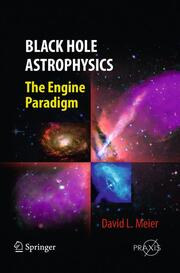Detailansicht
Black Hole Astrophysics
The Engine Paradigm, Springer Praxis Books - Astronomy and Planetary Sciences
ISBN/EAN: 9783662496091
Umbreit-Nr.: 9103559
Sprache:
Englisch
Umfang: xxxi, 927 S.
Format in cm:
Einband:
kartoniertes Buch
Erschienen am 27.07.2012
Auflage: 1/2012
- Zusatztext
- As a result of significant research over the past 20 years, black holes are now linked to some of the most spectacular and exciting phenomena in the Universe, ranging in size from those that have the same mass as stars to the super-massive objects that lie at the heart of most galaxies, including our own Milky Way. This book first introduces the properties of simple isolated holes, then adds in complications like rotation, accretion, radiation, and magnetic fields, finally arriving at a basic understanding of how these immense engines work.Black Hole Astrophysics- reviews our current knowledge of cosmic black holes and how they generate the most powerful observed pheonomena in the Universe;- highlights the latest, most up-to-date theories and discoveries in this very active area of astrophysical research;- demonstrates why we believe that black holes are responsible for important phenomena such as quasars, microquasars and gammaray bursts;- explains to the reader the nature of the violent and spectacular outfl ows (winds and jets) generated by black hole accretion.
- Kurztext
- This book begins by reviewing quasars, microquasars, and gamma-ray bursts and shows why black holes are responsible for them. It describes simple, isolated black holes, adding rotation, accretion, radiation and magnetic fields, to show how these objects work.
- Autorenportrait
- David Meier is a Senior Research Scientist and supervisor of the Evolution of Galaxies Group at Caltech's Jet Propulsion Laboratory in Pasadena, CA. David had an early career doing research in genetics at Washington University School of Medicine and in solid state physics at the University of Missouri - Rolla (UMR), before achieving his goal of research in astrophysics. He was educated in physics at UMR (BS 1971; MS 1973) and in astrophysics at The University of Texas at Austin (MA 1975; PhD 1977), working there under D. Schramm, B. Tinsley, and J.C. Wheeler on astrophysical jet production, galaxy formation, and winds from accretion disks around black holes. In 1976, with Tinsley, he predicted the existence of primeval Lyman break galaxies, which since have been discovered and found to have many of their expected properties. At Caltech and JPL David has been an integral part of a number of projects and missions involving observations of galaxies and black hole systems, including very long baseline radio interferometry (VLBI) in the southern hemisphere, VLBI using a space-based antenna (which created a telescope three times the size of the earth), and the space interferometer mission SIM. He also spent several years working on the US government's "star wars" project and was the group leader for parallel computing applications in that effort. While much of his recent work has been theoretical investigations of accretion inflows and outflows from black holes systems, David also enjoys occasional observational studies, using some of the satellites and telescopes on which he has worked. He also greatly enjoys his three grandsons, with a fourth soon to arrive.
